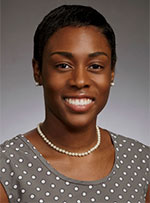Ashlee B. Daniels joined Trellis Foundation as a graduate fellow from January-July 2021. As she moves on to her next semester, Ashlee reflects on her experiences as a graduate student, chats with colleagues in her program, and shares her perspective on ways the Academy could better serve doctoral students of color.
The Gladiator VS. Doctoral Programs
Imagine that you are in a gladiator ring. The monster standing before you is twelve feet tall. All you have is your sword—a toothpick in comparison to your opponent—and a prayer. This feeling of being outmatched is exactly how a doctoral student feels. However, the student’s monster is their rigorous curriculum. And their toothpick-esque sword? The limited resources provided for them to succeed.
The doctoral journey for any individual is nothing short of a daunting task. There are very few who take up the call. To receive a doctorate degree is an honor and, by the numbers, quite rare. According to the National Center for Education Statistics, between 2009 and 2019, the number of students enrolled in postbaccalaureate programs only increased by 8 percent. Of these students, even fewer are Black and Brown students.
Higher education institutions serve a larger population of students of color than they have faculty members of color who could mentor and teach them. Black males, Black females, and Hispanic males each account for just 2 percent of full-time professors (NCES).
In addition, the spaces where doctoral students attempt to learn is not always accommodating. According to Marco J. Barker, doctoral students go through a phase of socialization where they adapt to various experiences within institutional spaces. However, Black students have socialization experiences that differ from other students of color and White students.
Student Perspectives on Institutional/External Organizational Support
To gain a first-hand perspective, I spoke with two classmates of mine in the Educational Leadership doctoral program at Prairie View A&M University (PVAMU). My classmates, Stephanie Tilley and Monea Beene, shared their perspectives on how institutions can better support professionals of color in doctoral programs. Both Ms. Tilley and Ms. Beene have extensive backgrounds in secondary or higher education. Ms. Beene is an Assistant Principal at Spring High School, located in Spring, Texas. Ms. Tilley is a Program Coordinator in the Office of International Programs at Prairie View A&M University. The following is a transcript of our conversation.
What attracted you to Prairie View A&M University?
Stephanie – I started working at Prairie View and enjoyed the community. It really does feel like “home.” With every family, there is disfunction, but I have never felt a sense of belonging more than at PVAMU. I wanted to be educated in a Black setting and learn about education from a Black and minority perspective.
Monea – I was taking my brother to a college fair, and one of the recruiters stopped me to look at PVAMU. I was looking for family, support, and to give back to my community, so the institution seemed like a good choice. The recruiter connected me with one of the professors in the College of Education. That conversation with Dr. Hoffman-Miller, who is now my professor, was so organic and exactly what I was looking for. I personally would not have chosen anywhere else to obtain my doctoral degree than at Prairie View.
As a Black Female, what does the doctoral journey look like for you? How does your identity affect your journey?
Stephanie – My doctoral journey has been a blessing and a labor of love. I am a first-generation student, and it has been difficult. It can be isolating when my family and friends do not understand the journey that I am on. However, I love to be challenged and learn from phenomenal individuals. Furthermore, being a Black woman means that there is an unspoken standard of excellence that we all must achieve, so I knew a doctoral degree would open doors for me and my family.
Monea – It feels good to be part of a program and be represented by teachers and mentors that look like me. It is very encouraging to see this kind of support, whereas, at other institutions, they do not have instructors that look like us. All are welcome at an HBCU, but my journey in particular means more because, as a Black woman, my identity has more weight and significance. I believe PVAMU wants students of color to thrive.
What actions by colleges and organizations could support more professionals of color?
Stephanie – Colleges can support more professionals of color by acquiring adequate staff and faculty personnel. External programs, such as the Trellis Foundation, should continue to fund programs that support professionals of color. Scholarships or internships can help us grow in various aspects. Mentorship and sponsorship are critical for students of color seeking a higher education degree. Sometimes, students of color do not have access to these things.
Monea – Colleges could support future professionals of color by being more proactive in publicizing job fairs and inviting competitive companies to PVAMU or other HBCUs. There should be mentoring and resources provided to students to help them secure a job after college. Exposing students to these opportunities could set them up for endless success.
Reflections on Institutional/External Organizational Support
After interviewing my classmates, two major themes emerged. I believe these themes could provide organizations with the tools to financially support students of color during their doctoral journey, and potentially support policies and practices implemented by postsecondary institutions to provide equitable spaces:
Transparent Support
Being transparent in supporting difficult situations is like addressing the elephant in the room. No one wants to address the problem—or even acknowledge that there is a problem—with how we treat and support students of color. We need a moment of pause to assess the campus climate and the health of its students.
A lot of thought is put into preserving institutions; however, the needs and voices of the students themselves are often forgotten. Perhaps, institutions and external organizations should consider implementing a student opinion survey to determine how to best support students. The analysis could then be used to determine an immediate need and inform how external organizations can provide support.
Innovative Practices and Strategies
Advancements in institutional teaching and student support practices are lagging; we continue with practices developed in the 1990s and 2000s rather than adapting to current student needs. We are seeing the emergence of a new generation: Generation Z. I am a Millennial, and I am young at heart, but Millennials are now considered “old.” The practices that were used for Millennials are ineffective for Generation Z, who prefers more visual and active learning tools.
It is imperative that institutions and organizations are prepared to change and evolve. I’ve found that some people are not pleased with change, but to move forward, we must embrace it. I think this could be a game-changer for most organizations in that it will provide a pivotal moment to positively engage with students and impact educational policies to best support them.
Also, I believe institutions and external organizations should be encouraged to support students of color who are at a disadvantage financially, academically, and socially in education. Furthermore, I believe this endeavor can begin by first listening to the voices of students served. It is important that we have intelligent experts in the field to help bridge the gap in how resources are provided to students of color in need. However, the difference in how we think aid should be provided to students and understanding the actual needs of students becomes difficult to distinguish over time. If institutions and external organizations surveyed students and learned their immediate academic and financial needs, then stakeholders and institutional administrators could use that knowledge to construct adequate practices and strategies to better assist students of color.
About the Author

Ashlee B. Daniels is a doctoral student at Prairie View A&M University studying to receive her degree in Educational Leadership. Her research focuses on how to best accommodate Black women in higher education through the lens of Edenism, a theoretical framework that she created as a solution for best critical thinking teaching practices and strategies for children of color. Her work is guided by Edenism to provide mentorship and support for Black female students matriculating through college and to prepare them for successful career positions. Ashlee’s research interests include the effects of diversity on college campuses, Black female leadership, the curricular implementation for students of color, and the articulation and manifestation of critical thinking skills by students of color at Predominantly White Institutions (PWIs) and HBCUs. For more about Ashlee, please click the following link to her professional portfolio: https://abdaniels.wixsite.com/ashlee-b-daniels

